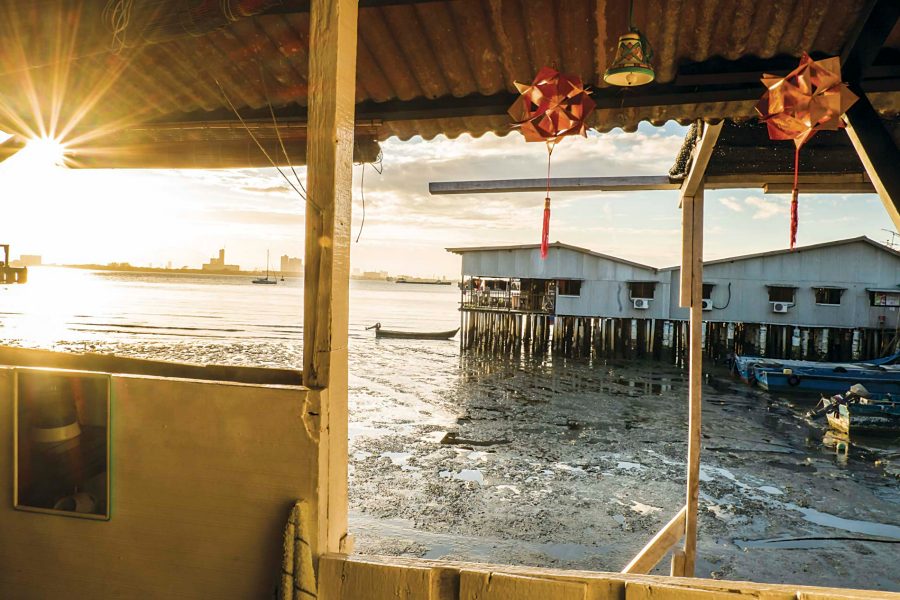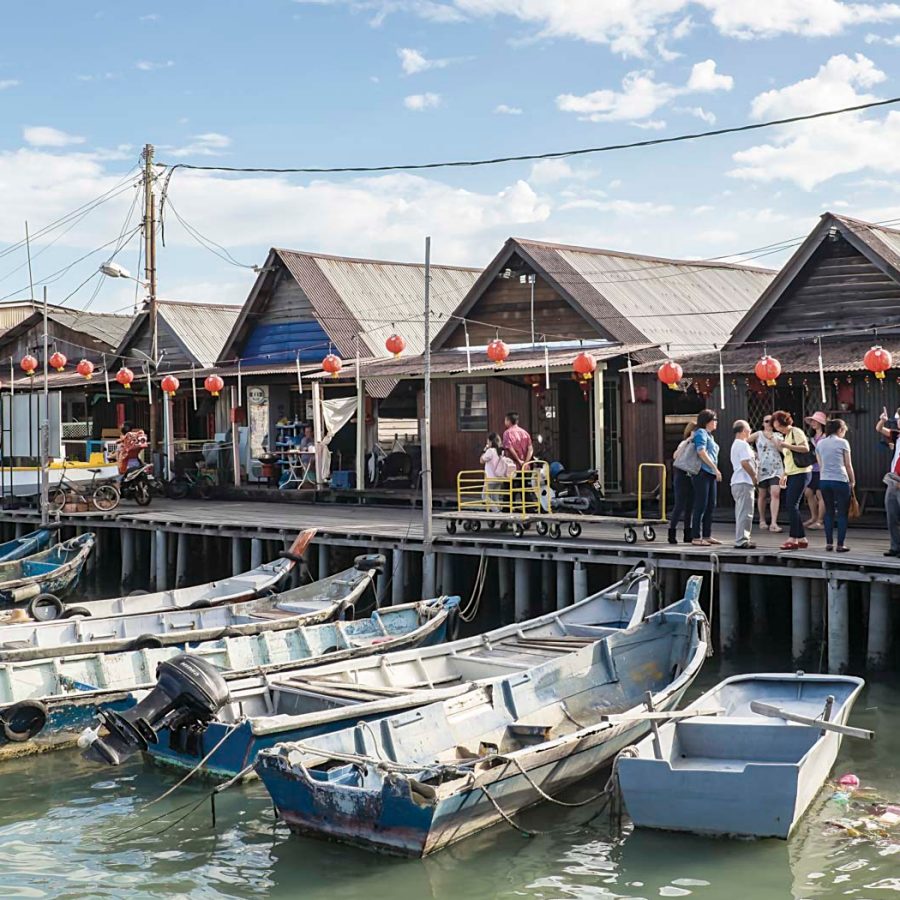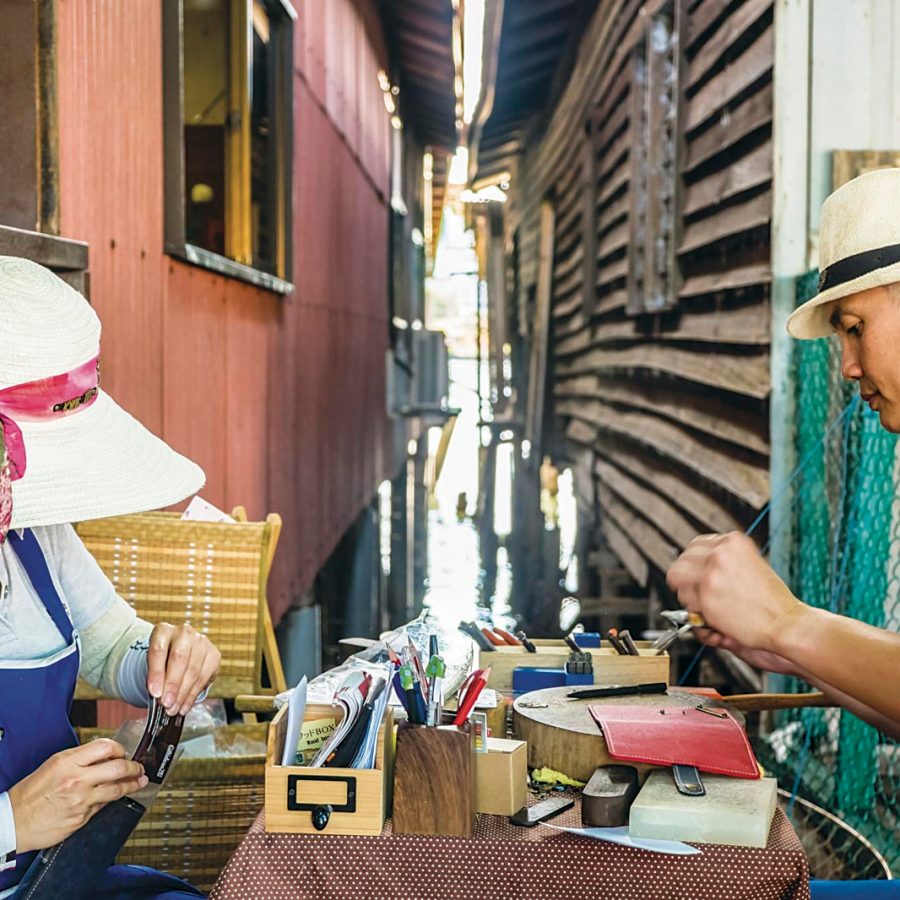The jetty set: Penang's waterborne clans

In Penang’s historic city of George Town, a cluster of homes recalls a bygone era. They aren’t the district’s trademark rows of colourful shophouses. These are at the timbered boardwalks, where the sea laps gently against the supporting stilts. It’s also where an old lady kneels and prays to the family shrine, much as her ancestors have done for decades. Nearby, children skip and run, and distant woks clatter away as dinner time nears. It’s a quiet scene in the evening, only dulled by commuter traffic as it passes just a few strides from the entrance to these wooden jetties, where clan homes sit.
Standing above the ocean waters that divide Penang from the mainland town of Butterworth, these jetty homes tell of George Town’s heritage as an immigrant hub. People from all over the world arrived in Penang more than a century ago, when the British colonialists turned the town into a thriving trading free port, bridging the oceanic gap between China and India. Chinese traders were prominent in the Weld Quay area of town and, after some time living in makeshift shacks, they built their own villages on jetties, which also served as trading posts. There were eight jetties in all, each of which was, and still is, inhabited by a different clan.
Chew Siew Pheng is a jetty resident and, as her name indicates, is part of the Chew clan. ‘My family first came and settled in Penang around 1880, from Tainan in China, and we are now the fifth generation,’ she says. ‘For a long time the trading and economy here were good, and most families prospered and so stayed living on the jetties. But in the past few years that has changed.’

Credit: Steve Thomas
In some cases, continuing to live here has not been a viable option. With low rents, jetty life may seem like an affordable choice, but this isn’t always the case as repair work does pile up thanks to the damage caused by saltwater. ‘We have to do a lot of maintenance and continually replace things, which works out to be very expensive,’ says Siew Pheng. ‘The area is also government owned, so we also have to renew our occupant’s licence each year.’
Thus far all jetty houses have remained with the original settling families, despite the dispersal of many clan members to the Malaysian mainland.
‘Before, most of the jetty people worked on their own and from home; but that time has largely passed, so now younger generations move to mainland houses and jobs, and help to support their parents who still live here, and they return home as often as they can,’ says Siew Pheng.
In 2008, the historic centre of George Town was listed as a UNESCO World Heritage Site, both to help protect its older buildings and also to recognise the unique racial and cultural diversity found in Penang. The accolade encompassed the clan jetties, bringing the above-water structures a great deal of new attention.
‘Being UNESCO listed has had both pros and cons,’ says Siew Pheng. ‘Because we don’t own the land, we’d previously had few rights to debate what happened to our homes. We risked losing them, with possible compensation of land-based apartments. But with the help of NGOs we sorted it all out so we could stay here, which was a plus. On the downside the jetties have become very busy, both with more family members and also with visitors, so it’s not the peaceful place it once was – although that’s progress and we have adapted.’

Credit: Steve Thomas
Of all eight jetties the Chew Jetty is by far the busiest, and has several small shops and eateries catering both to locals and the tourists looking to glimpse an old way of life. Siew Pheng’s family embraced the influx of visitors by offering My Chew Jetty Homestay, where guests could experience jetty life.
‘We have guests from all over the world staying with us,’ she says. ‘They are usually people wanting to experience real local living, and we often speak a lot with them, and I also sometimes cook and we have dinner together.’
With all the repairs required for these old structures, the business has also been vital for the Chew Jetty’s survival. ‘Financially it was the only way we could really afford to keep up the maintenance of the jetty. If we’d moved to land jobs and accommodation it may well have fallen into disrepair, which would mean that the whole jetty would just collapse.’

Credit: Steve Thomas
Despite the rigours of time, daily life for the majority of the jetty clans has changed little. This is why Siew Pheng and many of the younger generation are determined to ensure their survival and even their future prosperity.
‘For me personally I find life here very soothing and relaxing. Maybe it’s because we are living on the sea. When I open my balcony door I am directly facing the sea. It really relieves the stresses of life,’ she says.
But residents say it is the deep-rooted sense of community that makes the lifestyle worthwhile. ‘When you need help you don’t need to ask; people will come and offer,’ says Siew Pheng. ‘Doors are not locked and houses are always open to other jetty families. Unlike in mainland housing areas, everybody here knows each other and looks out for one another.’
More inspiration
Penang travel information
- China – the Chinese Mainland, Hong Kong SAR, Macao SAR and Taiwan Region
- Hong Kong SAR - English
- Chinese Mainland (China) - English
- Taiwan, China - English
- 香港特別行政區 - 繁體中文
- 中国內地 - 简体中文
- 中國台灣 - 繁體中文
- Africa
- South Africa - English
- Asia
- Bangladesh - English
- Korea - English
- Singapore - English
- Cambodia - English
- 한국 - 한국어
- Sri Lanka - English
- India - English
- Malaysia - English
- Thailand - English
- Indonesia - English
- Maldives - English
- ประเทศไทย - ภาษาไทย
- Indonesia - Bahasa Indonesia
- Myanmar - English
- Vietnam - English
- Japan - English
- Nepal - English
- Việt Nam - tiếng Việt
- 日本 - 日本語
- Philippines - English
- Australasia
- Australia - English
- New Zealand - English